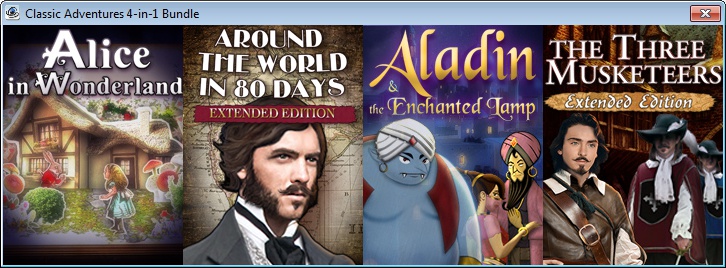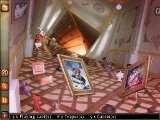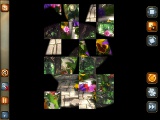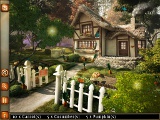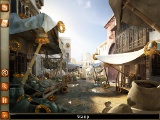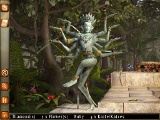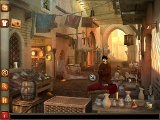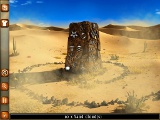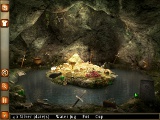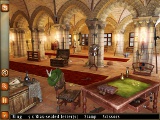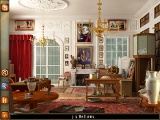





Epic Adventure Bundle 3-in-1:
Mirror Mysteries
Escape the Museum 2
Princess Isabella: A Witch's Curse
All games in this bundle are either the first or the second game in a series. The first two titles are also in the Ultimate Adventures Bundle 4-in-1, together with Secrets of the Dragon Wheel and Hidden Secrets: The Nightmare. But Hidden Secrets: The Nightmare is also combined with Escape the Museum in the Nightmare Museum Combo, so, as far as avoiding duplicate games is concerned, the 3-in-1 bundle is the better buy. For those who did buy the 4-in-1 pack: the last game is also combined with Robin's Quest in the Heroes and Villains Bundle 2-in-1.
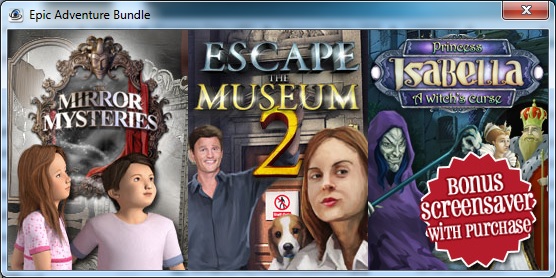
Having redeemed it while activation keys were still being mailed but not installed it until GamesBar became the standard, and after installing Christmas Adventure: Candy Storm, I can report a small Game Explorer boo-boo. After every new game installation, the Game Explorer gives all Gamesbar-related games the same icon: the winter scene that belongs to Christmas Adventure: Candy Storm. Then, after being opened and closed a few times, the Game Explorer may give these games their correct icons. Then, after another installation, all games have the winter icon again. These icons will all open the GamesBar anyway, so there's no point in keeping them, and after I moved the games directory off C: to make room for a download, Windows helpfully killed them for me. But the first game in the bundle got its very own icon, incorrectly called "Dark Messiah: Might and Magic", which of course did nothing.
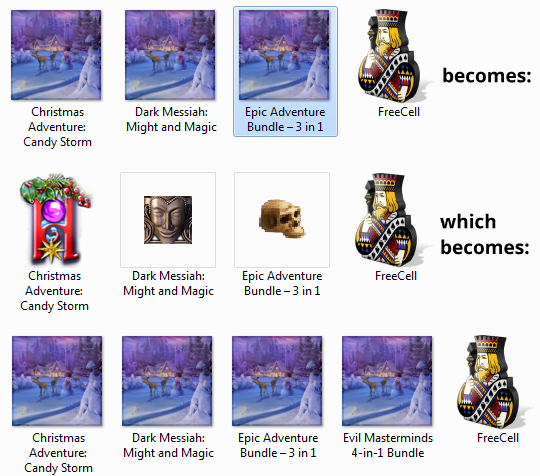
The very first thing that Mirror Mysteries wants me to
type, onto a torn-out notebook leaf in a sepia tone against a mirror, over which
hovers the game cursor which looks like a pyramid-shaped ice cube but is
supposed to be a shard of glass, is a name to make a profile; then I must tick a
box before I can play. Once a profile exists, starting the game will bring up
the mirror in its wooden frame topped by a smiling jester's face, showing the
four buttons of the menu. "Profile" is not one of these buttons, to change/edit
profiles I must click on the player name.
A car containing a young mother and two children is speeding on what looks
like an interstate highway. "Mom, I'm tired!" whines one of the kids, so the
mother agrees to stop near the odd wonky house the children point out to her.
She lies down and tells them, without moving her mouth, that it'll be just a
short stop while she rests her eyes (what, I thought the children were the tired
ones?) and they'll be off again. Two things about this intro: mommy's mention of
eyes does draw attention to what part of her face she slathers the makeup on,
and this game is, bleah, VOICED. What's more, mom is voiced with a nasal
American accent that proclaims "I think I'm a model mother and housewife, but
really I'm just a bitch", and as the end of the game draws near, her voice will
acquire the tense undertones that children associate with a hard slap and being
sent to bed without dinner. The voices are subtitled, but when I click the
dialogue away, the subtitles vanish too, so the only way to deal with them is
click on the Menu bottom in the bottom left corner (in any room except the
mirror room, this button is called Back, because the menu can only be accessed
from the mirror room), choose Options and turn the Sound level down. It's a
pity, since the voice actors have done rather a good job, especially on the
non-American-drawling characters like the mouse and faun. Anyway, the children
do not, of course, stay out of trouble, so she looks for them inside the wonky
house and sees them in the broken glass of a standing mirror with a jester's
head at the top of its frame, seven more broken mirrors lined up behind it. Her
little darlings have done this, and they'll stay inside the mirror until she
fixes it.
"Keep the little vandals, it will teach them a lesson about respecting other
people's property." The mother does not of course say this, nor does she
apologize for the damage or thank the mirrorjester for his reasonable offer. She
goes into Mama Bear mode: she'll do whatever it takes to Get! Back!! Her!!!
CHILDREN!!!! and from that point on, the scenes between the chapters will be
pissing contests between the supercilious mirror ("You surprise me, puny human")
and the raging mama ("I'm only doing this for MY BAYBEEZ and in no way accepting
responsibility for having raised such little monsters!") Each chapter (although
the game doesn't call it that) is a mirror that she enters, where she has to
find stuff in four or more "rooms", typically scenes of squalor and neglect, to
which houseproud mommy reacts with "oh, who could make a mess like this!" The
good thing about the voices is that they are only used to introduce a scene or
impart information and don't repeat themselves if, say, something is clicked on,
since every time I hear that bitch I want to reach through the screen and
throttle her; and jesterface isn't much better. So, most of the time, what I
hear is music, which starts out restful with an eerie undertone, and changes -
though retaining its soothing quality - to suit the scenic background of every
new chapter, like the faun in the wood who gets a bit of flute, and which I
enjoyed all the more with the recently bought headphones.
The tutorial can't be switched off; it's part of the game, as the
mirrorjester uses the whole first chapter to explain gameplay and may pop up
later in the game as needed. In the first, leftmost mirror she enters (followed
by the rightmost, alternating between left and right as she works her way
towards the middle) the mother is greeted by a mouse who needs her help
repairing a clock. Along the bottom of the screen is a row of images: the
objects, or parts of objects, that have to be found in the search screen,
possibly larger/smaller, but always the same colours, shape and orientation.
Every part found fades into invisibility in the object row, until the whole
object has been assembled and either gets a new heading "place it" (which, when
tired, I don't notice, so I fruitlessly keep searching for the found items) or
is whisked into the vertical inventory bar to the right that stores "shared
objects" which have to be placed in a different rooms from the one they were
found in. Where any completed object needs to be placed is hinted at by periodic
sparkles, and a dim outline if I mouse over that spot, as well as revolving
gears if I drag an object there. Any transparent images are like the
blue-lettered object names in various MumboJumbo games; they are hidden (for
instance, click on a drawer to open an "inside the drawer" screen) or don't
appear until some object has been placed, at which moment they become fully
opaque. At the bottom right, there is a self-recharging hint button - a mirror
over which a gleam of light glides regularly - that indicates either a hidden
item's location or a puzzle to solve, and a magnifying glass, also toggled by
the right mouse key, which is all but useless because of how much it distorts
the screen. There is also a book that isn't a journal, but acts as a "back"
button, going to the chapter's thumbnail screen or the mirror room. There is no
timer and apparently no reaction to misclicks other than one message referring
me to the hint button and magnifying glass; found and placed objects elicit a
demure "tingg" sound that goes well with the music.
Gameplay is strongly railroaded: each chapter has a main screen with
thumbnails for every room, and every thumbnail has a name and two numbers for
how many objects need to be found, respectively placed in it. Once I've done all
I can for now in a certain room, a message pops up to tell me so, and tosses me
back to the chapter screen when I click on it to close it. Once a room is fully
explored and solved, the same message even tells me I'm finished there, and the
room thumbnail's name is changed to "Finished". Most "puzzles" are solved simply
by putting an object in its place, and mirrorjester will usually be there to
give instructions; the first thing resembling a real puzzle, for which
jesterface didn't butt in, was having to rearrange the books in Queen Odelia's
bookcase. There are two or three other puzzles about doing things in the right
order, that require a solution scribbled on paper or a wall in another location.
Since the items to be found look exactly like their images, not discoloured
or rotated, they are disguised by clever placing: half hidden, or put over
something in a way that suggests they're part of it. The 3D art helps with this:
tastefully rendered in muted colours, mostly greys and browns, with extra tints
like gloomy red or greyish-green added to suit the locale, it makes sure that
nothing stands out. Just as the house looks wonky from the outside, the
perspective in its rooms is warped in all directions - see the stone stairs in
the frozen garden - and the scene even ripples in the underwater location.
Outside the house, the light and colours are as harsh as may be expected on a
sunny day, both when mommy has her little lie-down and when, at the end of the
game, she is woken by her children and gives them a Mama Bearhug. The windows of
the wonky house flash ominously, so she goes "oh no, not again" and hustles
everyone into the car, but the mirrors will return in the sequel,
Mirror Mysteries 2 - Forgotten Kingdoms, to
which she is not invited.
The list of credits is remarkably short, shows mostly Slavonic (Polish?)
names, excludes any voice actors, and includes the software used. At least one
person involved in making the game must have excellent command of English,
because although momma irritates me with her whining over an adventure that
should have provided a welcome change from doing housework and bringing the kids
cookies and lemonade, none of the dialogue is stilted. The king's introduction
to his frozen realm ("Look around, a lesson learned - never argue with your
wife.") was good for a smile, as was the explanation, smacking of Tolkien's
Mines of Moria, of the dwarf king why his hall was demolished. Clicking Play to
start over just brings up the final button, so, to play again (and redo the
tutorial, since it's part of the game) I have to create a new profile. Needless
to say, given the game mechanics, the game will play out the same every time.
This game shows how old (or compact) it is by being less than 100Mb in size,
and may need two or three mouseclicks to start it. A strange bug that occurred
when I started a new game immediately after a crash to desktop caused by the
battery running out: puzzles were pre-solved. For instance, a gem that still
needed to be discovered, hacked loose, cut and polished, was already lying
finished on the table.
It feels wrong to play Escape the Museum II before
Escape the Museum, but this bundle has been
lying around forever waiting to be tried out. So, here goes.
Like the previous game, this one is again by "GOGii Games", if I interpret
the splash screen correctly, and shows the same mastery of English, which by now
I have learned not to expect by default. It, too, starts by demanding a name,
then shows me a map with You Are Here on it. Under the map are the buttons Play,
Options and Quit, while over the player name is a bar-like button to change or
edit profiles. In both cases, the menus have been aptly and wittily designed.
The Options menu is a form, headed "This is an important document", where the
options are written as in a police report, and the volume bars look filled in
with a biro. To my delight, there are three volume bars, for Sound, Music and
Voice, although to my dismay the voices in cut scenes are not muted by turning
Voice down. As in the previous game, the voice acting is good. The profile
screen looks like an employee record. The "police series chase scene" music
playing while in the menu screen, and the game icon that appears to be a T-rex
skeleton (from the museum?), predict that this game will not be a relaxing one.
The intro is a comic seemingly in pencil and watercolour: mummy takes
daughter Caitlin to the museum but promises to be back in time for the family
Thanksgiving dinner, and reminds daddy, who is lying on the couch, to take his
heart pills. "Yeah daddy, we wouldn't want you to faint at every touchdown
again, do we?" snipes the daughter, thereby upgrading herself from "faceless
extra" to "brat". Dad wakes up to an earthquake and cries out that he must get
to the museum! Then, at what should be the start of the game, the screen starts
a wild carrousel of all application windows open while playing. I used the Task
Manager to shut down the webbrowser, a Chrome clone, and that stopped the
window-swapping. The game does hog the desktop, I found when tabbing out of it
and being thrown back in, or hearing whatever soundbyte was playing, continue to
play; there is an option under Options to have "Pause" on, presumably to pause
the game when using Alt-Tab, which says something, as all other Oberon Media
games I've played so far do that automatically. The art in the intro, cutscenes
and game screen is consistently good, although most faces have slightly naff
expressions.
The game is divided up into short levels that, when completed, show as stars
on the map, but these stars are inconsistently used, since they also appear in a
dialog rating how fast the level was finished. At the very start of the game,
dad says he needs his map and cellphone. What the player is supposed to infer
from this is that a map and cellphone need to be found in the wrecked living
room, their presence hinted at by sparkles when the cursor comes close. The
items are found: bam, level over. That was quick! He goes out and is met by
Catweazle, sorry, a tramp with a garbage bag who doesn't want to leave his stamp
collection behind, and promises to follow dad and help with hints. There is now
a vertical bar on the right with Menu and Inventory buttons and a heartbeat
monitor - the Inventory button opens two lists, of bridge parts, and side
quests - while an "I" button in the top left corner opens the bar at the top of
the screen that displays subtitles during dialogue, showing the last thing said,
and a portrait of the tramp that can be clicked on for a hint. A tutorial is
integrated in the game, but still, I'm left to figure a lot out by myself. The
premise: move the cursor all over the screen and click on the sparkles. Some
sparkles open a special search screen; although objects may have to be found and
picked up in the main screen, a proper search screen, with a list of items
(which may be discoloured or deceptively sized) to find in the bar on the right,
is usually a pop-up screen, and the portrait of Catweazle (who remembers that
character, anyway?) serves as very rapidly recharging hint button. Unsettlingly,
the way the hint works is that the tramp tosses a bottle which breaks apart on
the object. A good click results in a tingg, followed by the whoosh of an
opening suitcase if the object found goes into the inventory; a bad click causes
a brief red glow, and many bad clicks make red lightning appear and daddy's
heartbeat rise. Oh, and there are unskippable search screens where you have to
win hints by helping the tramp find a new "collection". In both cases, the
screens are the same every game. Dad rescues someone from a car and is told by a
police officer to stay in the park with the other evacuees, but sneaks off: he
must get to the museum! After this and each subsequent level, I get a summary of
how well I've done, and the map pops up, showing my progress and allowing me to
continue. If I do, I see a blurred still from the previous cutscene, and three
random family photos flash by, mostly of the dopey father, his repellingly
hard-faced wife and his bratty daughter.
Discovering every sparkle in the screen can lead to side quests, like finding
a puppy, and then a kitten, that both need to be returned to their owners. This
leads to situations that beggar belief, like a heart partient sailing over a gap
in the road using a skateboard, presumably - although this is not shown in the
animation - with a baby animal under his arm! And how the tramp manages to
follow him is a mystery. If not completed at the right time (ie. in the right
scene) these sidequests remain as unsolvable exclamation marks on the map, I try
to return to them but am simply whisked back to the latest scene as soon as I
click on anything. If I'm only one scene ahead of the place where I missed
something, I can still return to mouse slowly over the whole scene until part of
the scenery either sparkles or wiggles to reveal a bridge part or lost puppy or
boy or teddy bear underneath. The game is sped up just a little by the fact that
any inventory items I will need in a scene are moved out of the inventory and to
boxes at the bottom of the screen, which is good as there is an inofficial
timer: daddy's heart! Of course the dope forgot to take his pills with him, and
the longer it takes to complete the level, the more his pulse goes up. In the
shop where an assistant is trapped under an ATM, I have double incentive to
hurry: the inane repeating TV broadcasts that, like the cutscene dialogue,
clearly don't fall under "Voice". Okay, they're sort of funny, but too grating
to enjoy. Dad runs into Marcus (a colleague?) who says that his wife has been in
touch and is navigating her way out of the museum, making me wonder whether this
is a real sequel, or a retelling of the first game's story from a different
character's viewpoint. Because if mommy had got stuck in that museum before,
you'd think she wouldn't be daft enough to go back there.
The puzzles drive me crazy (Catweazle's directions don't always help) and the
sirens, aftershocks and dad's own panicked gasping would make this game
unsuitable for real heart patients; this is one of the rare games I'm reluctant
to play out till the end. Which is a very irritating (and unskippable) family
reunion scene where brat-daughter shows where the brat genes came from. After
which I'd better delete the player profile, because if I accidentally click Play
before making a new profile, that (unskippable) ending will be shown again. Oh,
and the music, that sappily suspenseful, Disney-film-dramatic background music
ending in triumph as the family finds each other again! But, to say something
good about the game: for those who can tolerate the stress and like to see
artistically rendered post-earthquake rubble, I can say the art is amazing. The
credits were again very short, suggesting a more international team this time,
leaving out the software, but listing most names under "Artists". As said at the
beginning, the English is good, except for some niggles: a "snorkle" is a
snorkel, "wooden/nesting dolls" are matrioshka dolls (although "nesting dolls"
aptly describes them), the "army men" were toy soldiers and the "worms" looked
more like leeches. Other than that, good work.
Seeing the third game's splash screen confirmed my expectation
that all games in the bundle were by "GOGii", and the splash screens have
certainly evolved: from plastic letters to balloon letters to cracked purple
plastic letters against a backdrop in more shades of purple, enlivened by
lightning and a thunderclap. To jump to the end: the credits were again
incredibly short, showing what looks like some French names, and the English
text was again fairly good, with the odd non-native expression, like "feather
pen" for quill: the only irregularities I noticed were the typo in "We can surly
find the ingredients to make a potion" in the piano room, and some cryptic
object descriptions in the to-find list, like "bad cabbage". I didn't see any
trace of the "bonus screensaver" promised, either under the Options (that
mercifully allow me to turn down Voice volume separately, more on why below) or
after having played the game out to its end.
The intro: a town crier announces the wedding of Princess Isabella, then the
sky darkens and a witch curses the castle. Through the wood outside the castle,
a figure in a shining white cloak gallops towards the courtyard: it's the
princess, who was out when the witch attacked. She is greeted by, ehm,
Tinkerbell, who relates what happened and offers a short, skippable tutorial.
Gameplay is basically the same as in the previous two games: move cursor all
over the screen and see what it does. It will change into a hand (with quite a
length of arm attached) if there's something to pick up, "examine" for a puzzle
or search screen, a jigsaw piece for a "puzzle" (can be a real puzzle, or
something as basic as "put item in place" or "open drawer"), and "curious" if
your fairy companion has something to say on the subject. There are no showers
of sparkles or revolving gears, although items that can be picked up may sparkle
briefly. The items to pick up are mostly notes from the queen's journal and
pieces of broken mirror, since the witch has locked "everyone in the castle" (
some six people) into mirrors and then broken them; if the pieces are put back
in place, they will be freed. There are also potions, four of which give the
fairy special powers: a rock to break things, fire to burn etc.; the powers are
clearly meant to be the four elements. These powers, once gained, are activated
by moving the cursor over the fairy, which brings up five circles: the four
powers and a hint, because the fairy is also a (self-recharging) hint button. In
search screens, where objects are not recoloured but simply cunningly placed,
she will snatch up every item found, and place the ones needed later in the
inventory. As if the snatching wasn't invasive enough, she never shuts up! She
comments when using some game option, or when clicking on something "curious",
and unlike the characters in Mirror Mysteries, will do
this every time. I soon turned down the voice volume. All puzzles, which
include samegames to brew a potion, tunes to play on various instruments, and a
marble popper ("Zuma!") are non-skippable, so it's
just as well that nothing is timed. As the fairy will explain to me whether I
want to hear it or not, there is a Quest Journal in the bottom right corner
which doubles as fast-travel map. The menu button (to access game options and
shut the fairy up) is in the bottom left, over the blurry picture of which
character is to be freed from the mirror next.
The art is very, very pretty, both the castle scenes and the search screens:
the very first search screen in the courtyard looks bathed in the warm golden
glow of sunset. When assembling pieces in one of the mirrors, they float over
the mirror in a ghostly way; when entering a room for the first time, it will be
"cursed", grimy and cobwebbed (but already pretty) but once the curse is lifted,
it looks like a room in the Louvre. As I move around, a mini-map in the top left
shows me where I am, and once everything that needs to be done in a room is
completely done (and if you get stuck, as I did: the dining room is really two
rooms) the room gets an "area cleared" label. The to-find lists in search
screens, which sometimes need a puzzle solved to fill them, are the same for
every game. I found it rather off-putting to have to search for "evil objects":
snakes, skulls, spiders, goblin statues that I recognized from
Mystery of Unicorn Castle, but the change
from paintings depicting violent scenes to peaceful ones is a nice touch. The
little musical flourish played at the end of any solved puzzle or completed
search screen is straight out of Mystery of Unicorn Castle, and the
wistfully eerie music, changing to happy fairy music for every room where the
curse is broken, also reminds me of that game. As does the final showdown with
the witch, the only scene that has anything like a timer. If I finish the game
and then restart it using the same profile, this hectic finale is replayed.
The witch is finally defeated in the sequel:
Princess Isabella: Return of the Curse.
Dream Chronicles: The Book of Water
(See the earlier Dream Chronicles for what went
before.)
The opening screen of The Book of Water shows what appears to be the
bulbous-eyed head of a giant fish standing up straight from the water, amidst
thunder and lightning. It is in fact a house with lit windows, bobbing on the
angry waves, and a reference to Barge City, mentioned in the third game, which
we will finally get to see. In the last game, The Book of Air, Lyra
returned to her beloved town of Wish (I can't help it, she keeps saying that) to
see a storm brewing above it; in this game, which has an actual Book of Water in
it, and which hints that the sequel will be named "The Book of Fire", she
crashes at its gates. It takes her some effort to enter her own home, but when
she gets in, daddy Fidget is lying on the couch looking very ill, and now it's
mummy who has gone missing.
When Lyra was whisked away in the previous game, I assumed this was a second
attempt by the Dream Librarian to collect the Chosen Child. It's still possible,
but the note outside the gate warns that Lilith has taken over the town, and
according to mummy's letter, illustrated so I now have a rough idea how the
hereto unseen characters look, has reared a little human/fairy hybrid of her
own, who has joined her on her rampage. Mummy has gone to the herbalist for a
healing potion, and then left to collect some magical symbols, and Lyra must
follow her and finish her work.
If this gives the impression that there's not a lot to do in the game, that
is correct. The makers scrapped the little things which they probably thought
the player would find tedious but which I enjoyed, like the samegame to fill up
the airship's tank and the setting of its course, and while two beautiful new
locations are revealed - the toy shop's interior, and Barge City - locations
from previous games are also revisited, except I can't do the stuff I could do
before, like go upstairs or enter the garden through the kitchen, which is
irksome. Again, the dream jewels are just colourless shards that activate four
powers - the power that puts broken stuff back together being one that I wish
were real - only, there seem to be far fewer of them. There are no puzzles
featuring music, so I can safely turn the sound down, but the fourth power,
which allows Lyra to follow her mother's trail, has her speaking aloud despite
the volume settings, and the voice used is blander and less anxiously earnest
than that in the previous game. The puzzles that it does have are fun, and I'd
still recommend it simply for the atmosphere. Also worth mentioning is that
there are now two hint buttons, one to find things and one to display the
current tasks so the player doesn't need to constantly consult the book, that
the menu screen has a button that lists the previous games, and that although
after finishing the game you can start over, it's better to create a new player
for a fresh game, because when I finished and started playing again from the
beginning, I ran into problems at Lilith's statue because the game suddenly
switched to the final scene, even though I hadn't collected the necessary items;
so I was stuck!
Also, sadly, this was the first game I bought for which I didn't get an
activation key, since as of now all games would be run from a Game Manager, and
if I were to reinstall any older games, they too would be the keyless build.
Which means that Oberon/CasualGames now does what I hated Big Fish Games for
doing.
Classic Adventures 4-in-1 Bundle:
The title of this bundle comes from the fact that its games follow the
stories of literary classics, that is to say, stories everyone knows even if
they didn't read the book. All are by HdO and have identical interfaces, flaws
and qualities.
Not to be confused with another Alice
in Wonderland game, the first game's full title is: Alice in
Wonderland: The Incredible Adventure (Extended Edition). Since the game
isn't that long, this makes me wonder how short the unextended version must
have been. The game briskly walks the player through the main plot points of
Lewis Carroll's Alice in Wonderland through hidden object screens,
minigames, and dialogue and illustrations from the original. Never having read
the original and only knowing these plot points from derivatives like the Disney
film, I don't know how much was left out.
The introductory screen implies that this is going to be a 3D scrolling game,
but after finishing a game, I get the impression that this was a new feature
that was mostly implemented for show - rather uselessly, both intro and ending
scenes scroll, but hardly any of the real search screens do - and the game
generally is either old or slightly sloppily constructed. The intro screen lets
me go to the Profiles screen or start a new game, and it's here that I have to
enter a name and choose a game mode (timed or not) before being subjected to a
thorough gameplay explanation. Once the game is finished, I can replay it
without having to make a new profile, but the whole explanation will repeat
itself, even though the profile already exists and has a score; there is no
"skip instructions" button. In the minigames, this is even more annoying,
because every button will be re-explained at the start of every minigame. (I
later found that the instructions were being repeated because I played first in
non-timed, then in timed mode, which was interpreted as "playing this game for
the first time". When I replayed the non-timed game, instructions were skipped.)
The sloppiness is apparent in the find list, a black bar at the bottom of the
screen. Here, the names of items to be found appear three or four at a time,
often as multiples, ie. "three hats", but where the average hidden object game
switches to the singular when only one of the items remains, this game shows
both singular and plural all the way, ie. "hat(s)", which is very ugly in words
with a less simple plural, like "scar(f/ves)". The makers were obviously not
native English speakers: there are three outright mistakes in the find list
("helm" for ship's wheel, "canvas sack" for burlap sack, and "club" for a clover
leaf), every type of minigame puzzle is called a "jigsaw", the whack-a-mole
minigames are described as "tap-to-shoot" (leading me to expect a crosshair) and
the explanation of how match-3 works would have had me befuddled if I'd never
played match-3 before. The unskippable gameplay explanation tells me that
misclicks are punished by screen blacking and losing seconds off the clock, but
in untimed mode, misclicks seem to have no consequence. However, as well as
clicking on objects, I can clear away bits of background, like bushes, that hide
objects from view. The bits of scenery advertise their clickability with a brief
glow, which I don't always notice on time, so I'm perplexed when I think I'm
clicking an object on the list and instead, the bush is gone. In the whole
lengthy pre-game explanation, might this not have been mentioned? Lastly, the
background music, a rollicking "fairytale character takes a walk in the
countryside", track, is sometimes replaced by a "beware, danger!" track, a
change that has no connection with the scene shown: the danger track was played
in front of a cupboard of jam, while the jolly track was played in the court of
the Queen of Hearts. What's more, alt-tabbing out of the game to paste a screen
capture and then switching back to it also changed which track was playing.
Oh, and the split screen in the "find the differences" minigame has only one
cursor instead of the customary double cursor. There, I'm done complaining.
I played in non-timer mode first, to check the game out at my leisure. It
appeared so simple and charming to me that I wondered if it had been made for
young children. The hidden objects destined for the inventory give their
positions away by glowing, hidden objects generally, although they may be mere
silhouettes, are not as deviously concealed as I'm used to, and the earliest
minigames would only rack the brains of a toddler. They do get a bit harder as
the game progresses, and a rare few of the objects are so invisible - even if
the screen is at the brightest setting, as recommended in-game - that it takes
several hints (for the same item!) and much random clicking before I can move
the story along. The hint button is self-recharging, but hints are limited,
starting with three at a maximum of six; more hints can be won in the minigames
or by clicking the six-pointed star that pops up randomly in search screens (in
timed mode, this star adds not hints but time on the clock). A found item
disappears in a cloud of sparks with a "plingg", "pop" or "mmm" sound.
The art is either rendered in 3D as bright, cosy backgrounds and somewhat
flat, milky objects, drawn in fine lines (like the swirl of cards at the end) or
lifted from the original book's pen-and-ink illustrations and optionally
coloured in. It really makes the game; the early and ending search screens are
genteelly psychedelic, the rabbit's house is a dreamy cottage and the Queen of
Heart's castle is to die for. The game is unvoiced, producing rectangular
rounded text balloons with dialogue more or less lifted from the book.
On trying a timed game, I revisited my opinion that it was aimed at young
children; the searches are split up into many small steps, and each step is
given so little time that I had to click fast to avoid having to redo a search.
An initially overlooked intro screen button is the "bonus" button at the
bottom, which is grayed out until the game has been played out once. It opens a
screen where all minigames can be replayed.
Around the World in 80 Days is another Extended Edition
that doesn't seem all that long, an impression strenghthened by the game's
reporting that the main character spends most of the journey playing whist. The
summary that everyone knows: a French servant so versatile that he gained the
nickname "Passepartout" is tired of having to be a jack of all trades and has
therefore applied for domestic service to an eccentric Brit who is known to live
by the clock. Sadly, this is the day that said Brit, at a club, enters a bet
that he can travel around the world in 80 days. Also, there has been a robbery
recently, and a police officer misinterprets his sudden departure from the
country and follows him on his journey in an attempt to bring him to justice.
Oh, and there is a rescued Indian princess that I was not aware of.
This game has exactly the same intro (with useless scrolling screens),
interface, buttons, needless explanations and lack of explanation where it would
be useful, six-pointed star for hints or extra time, language errors, and
end-of-game bonus button to replay all puzzles, as the first one; but the
puzzles are less infantile, the plurals are handled better (both singular and
plural are shown, so "scarf/scarves", instead of "scar(f/ves)") and not only is
the scrolling feature used in more search screens, but some screens scroll
vertically. It isn't indicated whether a particular search screen scrolls or
not, the only way to find out is to give it a tug and see if it moves. (The
secret is: non-scrolling screens have a magnifying button, and will scroll once
zoomed in. In scrolling screens, this button is deactivated.) Finally, this game
shows the same pocket watch while loading a screen as the previous one, which is
not surprising, as a pocket watch is central to both stories.
To rattle off the mistakes: in one minigame where I have to find gears, said
gears don't look like the examples in the to-find bar, as they are black until
clicked on; it would have helped to know this. The find list contains the
following errors: a cleaver is a "chopping knife", a safe is a "closed chest"
(fortunately, it's one of those items that start glowing), a fountain pen is a
"pen holder", a pair of compasses is a "compass" (a mistake frequently made by
those who don't speak English as a first language), and what most hidden object
games call a "life preserver" is called "mud" - I have no idea where that came
from! Despite being non-native speakers, the gamemakers still test the player's
English vocabulary when it comes to geography and spices. The puzzles are not
only less simplistic, but more demanding: many are "card game" puzzles where
cards have to be clicked away in the right order, and a misclick means that the
game starts over, with the timer reset to zero. The to-find bars in search
screens more often show silhouettes instead of object names, and there are more
frequent riddles, like the description "this is where I will rest for evermore"
to find a tomb. Although the objects are again not terribly cunningly hidden, I
did find that the penalty for too many misclicks does work here in untimed mode.
Finally, it is again the graphics that make the game. Against the
heroic-sounding music track that signifies "Englishman bravely embarks on long
journey", I am presented with very lifelike avatars, alternated with pen-and-ink
sketches from the original, and scenes that convey the atmosphere of their
locale: gloomy London and the austere, but luxurious British club, sunlit Egypt,
vibrant India, cherry-blossom-filled Japan and dusty central USA; and finally
back in cheerless England for the happy ending.
It must be embarrassing to misspell the name of the main
character in the very title screen, but as I'd noticed before, the makers are
not native English speakers, and maybe this is the right spelling in their
language. Right then: Aladin & the Enchanted Lamp (his name does get the
correct English spelling within the game) is exactly the same as the previous
two games where game mechanics are concerned, with the same pocket watch for
loading screens, uselessly scrolling intro/ending screens (but here they serve
the purpose, at least, of giving a panoramic overview of Aladdin's city) and the
following mistakes that can befuddle the player: in the palace search screen,
"arc" means bow, "calyx" means chalice, "register" means book (well, technically
a register can be a book) and "iris" refers to the painted eyes on the wall,
don't bother trying to find the flower. Oh, and a niggle: the reddish canine in
the desert is either a jackal or a dhole (it looks like the latter) but
obviously not a coyote, while what is called a "caterpillar" looks like a
curled-up millipede. And the dialogue is rather stunted, and the treatment of
plurals is halfway between the approach of the first and of the second game:
it's now given as "knife(-ves)".
There is one extra button, though: click on the "T-shirt" button and a
picture will pop up of Aladdin in his current state of dress; whether as pauper,
servant or prince. The art is now cartoonish; the characters look like animation
cels when in a search screen, and like paintings on textile when their avatars
pop up. The 3D rendering is one step up from the previous game: with the game's
brightness setting at maximum, the market really does look hot and dusty, while
the desert scenes are unexpectedly crisp and vivid, and the multilayered
scrolling effect, already present in the first game, didn't catch my eye until
this game applied it to the savanna. This game uses both silhouettes and
coloured images instead of object descriptions from time to time, and although
it only plays one "snake charmer music" track, the ambient sounds of
marketplace, bath and garden round out the soundscape nicely. The minigames are
either "domino" (arranging the tiles in the right order), match-3 or
whack-a-mole, and the end-of-game bonus button reveals that there are very few
of them. Maybe I didn't notice because this game has me running around so much;
it happens several times that I follow an arrow to another screen only to be
presented with a new arrow to click. I'm finally getting the hang of gameplay:
the long explanations at the start of each minigame can be cut short by clicking
the "close" button to start playing, and although the inventory annoyed me at
first because I couldn't drag items down from it, I now know the correct
sequence: click on spot in screen where the item will be applied, the inventory
will now slide open by itself, click on item in inventory.
The gamemakers seem to have taken great liberties with the story, though, or
maybe this is the original and storybooks for children have dumbed it down. In
the story as I know it, Aladdin is conned into entering a cave on an artifact
hunt by a villain who fully intends to leave him there; in this game, he gets
stuck in the cave through his own fault, there are two genies, and the villain
isn't who it appears to be. The pauper turned prince marries the princess's
cousin, and the sultan doesn't get either his palace or his daughter back.
The full title of the last game is The Three Musketeers:
D'Artagnan and the 12 Jewels (Extended Edition). To avoid confusion, the
jewels are all strung on the same chain and the game's main objective, once
we're past rookie d'Artagnan managing to stumble into and insult the three
biggest names in the musketeering scene, is to recover this chain. The game's
interface is again identical to that of the previous games, except that the
loadscreen image is no longer a pocket watch, but a folded cloak on which rest
crossed rapiers and a hat. D'Artagnan has a lifelike avatar that smiles and
frowns; the other characters are represented by silhouettes or hats in a search
screen. The game opens with a desk on which lies the novel, open at chapter 1,
and borrows from its illustrations.
Although the wooden descriptions and conversations underline that English is
not the makers' first language, the game has the same annoying habit as
Aladin & the Enchanted Lamp of taking the player through a succession
of screens rather than going straight to the relevant screen, and this game
comes up with the ugliest plural yet - "Loa-f(-ves) of bread" - none of the
object names in the to-find list, however clumsily expressed ("cutting knife"
for cleaver) are totally unguessable except for "duckboard" for a wooden
lattice, and who knows, maybe that's the correct term. The game uses object
descriptions, silhouettes and images in the to-find list which, in the case of
the latter two, becomes higher, causing the screen to scroll vertically. There's
a nice mix of different kinds of minigame, although most of them are of the
whack-a-mole type. The graphics, as in the previous games, are the best part,
giving an authentic "period" feel to the game. The single "ta-da-dum" track
constantly playing in the background already suggests the galloping our heroes
will be doing for the second half of the game.
I played this one with some interest because although "The Three Musketeers"
is a familiar phrase, I didn't know this particular story. Well, it is silly.
The Queen's honour has to be protected because she did something not very
sensible, and the rest of the story can be summed up as "one-two-three-DUEL!"
So, not only did I have fun playing this game, but it also let me know that the
original is not worth reading; and that's something to be grateful for.
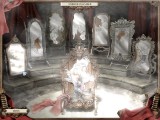
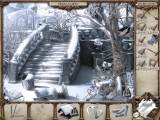
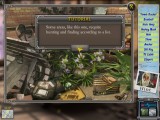
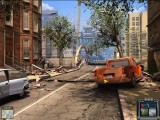
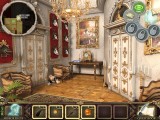
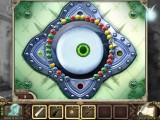
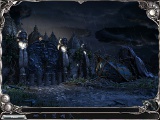
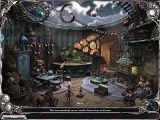
Alice in Wonderland
Around the World in 80 Days
Aladin (sic) & the Enchanted Lamp
The Three Musketeers
